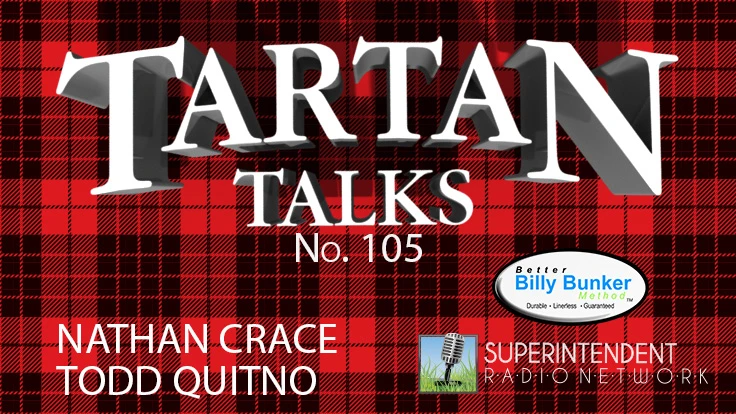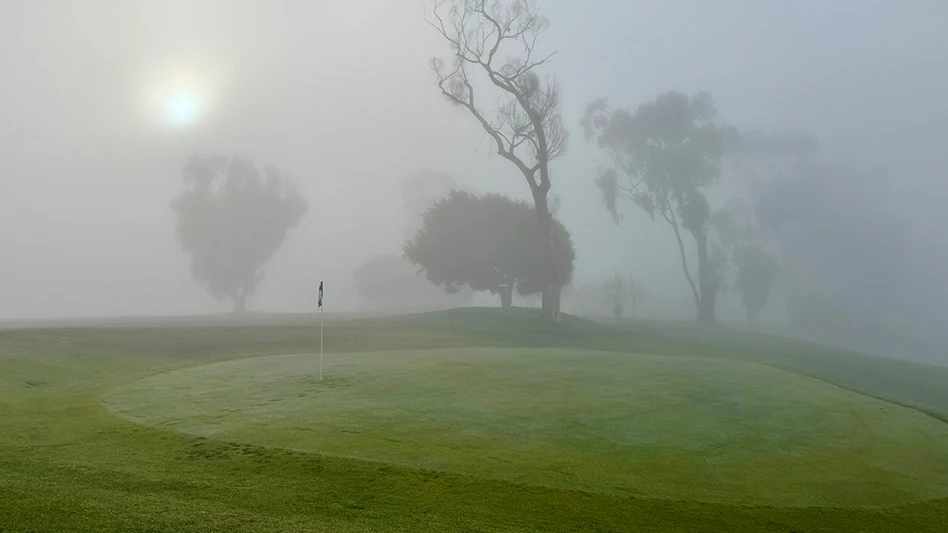Let’s get one thing straight right now. Charlie Birney, the grand high poobah … er, I mean president … of the National Golf Course Owners Association, is a lunatic.
No, he’s not a raving, knife-wielding serial killer or anything like that. He’s just a mildly wacky guy who sends self-drawn cartoons and odd pictures along with every e-mail. He’s incapable of staying on point in a phone conversation. You ask him a simple question about the golf courses he owns, and you end up talking about 17th century archeology and exotic bird species.
But that’s the beauty of Birney. He’s a lunatic who’s passionate about the golf business. And the industry will be better off for it.
Birney was born with a terra-cotta spoon in his mouth. Specifically, he’s a descendant of the founders of The Brick Companies, originally the Washington Brick & Terra Cotta Co., one of the region’s great accidental fortunes. Way back when, one of his ancestors was smart enough to realize that building Washington, D.C., would require a great many bricks, and established a company to provide them. The business was successful, but the land on which the company operated also happened to be the area of northern Virginia that’s now called Crystal City. The family eventually sold that land to companies such as Charles E. Smith and Marriott. Today, Crystal City is packed with hotels, office buildings and government agencies. Suffice it to say that The Brick Companies made a small profit along the way.
The company hasn’t produced a brick since 1939. Instead, it focuses on managing and developing commercial properties and real estate, including three courses in a division called Atlantic Golf. When he’s not busy with NGCOA stuff, fund-raising for the company’s charitable foundation or doing wacky stuff with his wife and twins, Birney serves as the managing director for the company. He started his two-year term at the helm of the owners association in February, so it’s a good time to ask him about his plans for the organization and his views about the state of the industry.
Why did you volunteer for NGCOA in the first place?
I went to an NGCOA conference years ago, and it wasn’t good. I was underwhelmed, and I said so. But I was impressed with the staff. Before I got involved, I’d spent a great deal of time and money opposing the growth of municipal golf in our area. I was a private sector guy competing against a government agency. I started to go to hearings where the county was trying to get even more active in golf development. I said, ‘Look, this is a travesty. You have no business building courses.’ Eventually, we sued them and forced them to change their charter. Unfortunately, this allowed them to do whatever they wanted to do. It’s pretty darn hard to oppose government development.
I became involved with a lot more political stuff because of that and lobbied for tourism as a member of the Maryland Tourism Development Board. A friend, John Shields, was leaving the board of the NGCOA and helped get me involved. At the time, Bill Stine was dumb enough to nominate me for the board. I’m still passing the hat for my own impeachment fund.
Is there any legitimate role for government to develop new golf courses?
There might be places – and I’m not aware of any – where governments should be creating new golf courses. But, as a rule, the government shouldn’t be building any new courses. There are plenty of idiots like me who are willing to do it. I’d like to see existing muni facilities privatized, but the problem is counties such as Montgomery County in Maryland have a stranglehold on golf. Typically, these courses aren’t really run by the county but by a ‘revenue authority’ or similar mechanism so the jurisdiction can act outside its standard responsibilities and take on projects that compete with the private sector. They should have better things to do. So, I don’t think the government should be building golf courses … or the PGA Tour for that matter.
Tell us about your courses.
They’re three very different facilities – different styles, price points and locations. South River outside Annapolis is transitioning to private and hopefully will be profitable. There is a lot more rise and fall to the course than you would expect from land in this area.
Queenstown Harbor is a special course right on the Chester River and the Chesapeake Bay. I can’t think of a course in the area with better views of the bay from so many holes. It’s wrapped in great history as well. And Queenstown is a players’ course. Even I can appreciate what a great golf course it is, and I stink at golf.
Potomac Ridge is in southern Prince George’s County. The National Harbor project, located 10 minutes across the Potomac River from Old Town Alexandria, is opening this April and includes a 2,000-room Gaylord Hotel. We’re looking forward to some golfers from the hotel’s conferences.
You seem very focused on the environment.
We’ve had to be, just to do business and get permits, but we’re trying to make a stand environmentally from top to bottom. We’ve led the way locally. We’re doing lots of little things, such as installing rain barrels at our facilities and using cups made out of corn in the cafe. We’re getting back into Audubon International certification, and we’re hosting the first golf tournament for the Chesapeake Bay Foundation. I’m proud of this, considering the bad environmental image that golf courses have. The ‘green’ aspects of Queenstown Harbor are a large part of the marketing for this tournament. Heck, I even drive a Prius, which is really small but gets fabulous gas mileage.
What are your challenges, and how do they differ from typical NGCOA facilities?
We’re not a mom-and-pop operation, and we’re not a huge golf management company. We’re in between. But our challenges are probably more like NGCOA’s mom-and-pop members. Luckily, our portfolio includes office buildings and other stuff that’s helped us get through lean times. Also, while I don’t think the environment is a huge issue for most courses nationwide, it’s still a big issue for us. One of the constant challenges is dealing with an outdated perception that golf courses are inherently bad for the environment.
Quite frankly, economics are driving us to be more careful with chemicals. Money also can be a good environmental motivator. We’re also getting serious about water use – we changed our fairway grasses at Potomac Ridge to zoysia to be less thirsty. Water restrictions are going to come and we need to be prepared.
Are you going to be active on the national level in terms of lobbying?
Absolutely. The whole industry is getting more active and pushing things such as green carbon credits for golf. The industry has hired new lobbyists to push that, and we’re having a “Day on the Hill” in D.C. this spring. There’s a huge future potential for golf courses to be viewed as environmental resources for communities. We sort of led the way in that when we lobbied for and received “open space” designation for courses in Maryland.
Do you feel good about the business now?
Yeah right! We’re temporarily closing one nine at our 27-hole facility in Prince George’s County because play is down. Still, I’m confident that the huge influx of housing, not to mention those 2,000 hotel rooms, will drive play. The future for that facility is bright. But on the whole, we’re working hard to keep our rounds consistent. That truly has been a sign of the current state of things.
If you could wave a magic wand and change one thing about the market, what would it be?
I’ll pick two. First, more accessibility for young golfers and, second, erasing the bad perception that courses have regarding the environment.
What are your goals as NGCOA president?
I want to push the sustainability/environment issues as much as possible. We have “fixed” a lot of the problems from years back, and the products and practices are getting better all the time. I talked to one of the Toro scientists at the show and got jazzed about some of the environmental technologies coming down the pike. We’d love to be a test case for some of those innovations.
How often do you get to play?
Not very often. After talking with NGCOA executive director Mike Hughes about the importance of nine-hole play a few years ago, I started the “Friday Morning Irregulars.” We have a big group that’s invited to meet at 7:30 in the morning, on Fridays, and play the back nine – so no sellable tee times get used. I charge $15, and it all goes to charity. It’s a blast. Other than that, I don’t get out too much, except for the occasional tournament.
What advice would you give to an aspiring golf course owner these days?
To analyze the community needs and make sure he or she knows what’s on the municipality’s development plans. It just makes me nuts that cities and counties keep developing courses. Yikes!
If you could turn back the clock 20 years and change your career, what would you do differently?
That’s a loaded question. If I had known about the golf career, I definitely would have tried to play more and learn more about the game before building a course. But there are only a few things I would change.
The best part of all was that for many years I was able to work with my father, Arthur Birney Sr., who just turned 80 and is still active, and that had been my dream. He’s a fantastic man, and everyone loves him. The nicest compliment I ever received was while I was giving a toast at the wedding of one of my closest friends, when a little old lady leaned next to her friend and I heard her say, ‘He’s just like his father.’ That was wonderful. GCI

Explore the April 2008 Issue
Check out more from this issue and find your next story to read.
Latest from Golf Course Industry
- Beyond the Page 65: New faces on the back page
- From the publisher’s pen: New? No way!
- Indiana course upgrades range with synthetic ‘bunkers’
- Monterey Peninsula CC Shore Course renovation almost finished
- KemperSports and Touchstone Golf announce partnership
- PBI-Gordon Company hires marketing manager Jared Hoyle
- Mountain Sky Guest Ranch announces bunker enhancement project
- GCSAA names Joshua Tapp director of environmental programs





